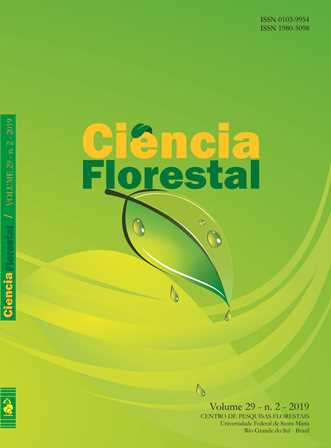Modeling of tree recruitment by artificial neural networks after wood harvesting in a forest in eastern Amazon rain forest
DOI:
https://doi.org/10.5902/1980509825808Keywords:
Ingrowth, Artificial intelligence, Forest managementAbstract
The modeling of recruitment in tropical forests is important for studies of forest management sustainability, for giving adequate subsidies to the recovery of wood stock. The objective of the work was to estimate the recruitment after wood harvest, using a model of artificial neural network (ANN). The study area is located in the Tapajós National Forest (55° 00' W, 2° 45' S), Pará. In 64 ha of the study area, in 1979, an intensive harvest of 72.5 m3 ha-1 was carried out. In 1981, 36 permanent plots of 50 m x 50 m were randomly installed. These plots were measured in 1982, 1983, 1985, 1987, 1992, 1997, 2007, 2010 and 2012. To model the recruitment the variables of target subplot and its neighborhood were considered. The estimates obtained in the training and generalization of ANN were evaluated by statistics: correlation ( R) and root mean square error (RMSE) being obtained RMSE 35.6% and 0.89. It was possible to model the recruitment tendency over the time in tropical forests, after the wood harvest.
Downloads
References
ALVARES, C. A. et al. Koppen’s climate classifcation map for Brazil. Meteorologische Zeitschrif, Stuttgart, v. 22, n. 6, p. 711-728, 2013.
BINOTI, M. L. et al. Prognose em nível de povoamento de clones de eucalipto empregando redes neurais artifciais. Cerne, Lavras, v. 21, n. 1, p. 97-105, mar. 2015.
BINOTI, M. L. et al. Redes neurais artifciais para estimação do volume de árvores. Revista Árvore, Viçosa, MG, v. 38, n. 2, p. 283-288, abr. 2014.
CASTRO, R. V. O. et al. Artifcial Neural Networks Effectiveness to Estimate Mortality in a Semi-Deciduous Seasonal Forest. Australian Journal of Basic and Applied Sciences, Amman, v. 9, n. 5, p. 435-444, 2015.
COSTA FILHO, P.; COSTA, H.; AGUIAR, O. Exploraçao mecanizada da floresta tropical úmida sem babaçu. Embrapa-CPATU. Circular técnico, Belém, v. 9, p. 29, 1980.
DIAMANTOPOULOU, M. J. Assessing a reliable modeling approach of features of trees through neural network models for sustainable forests. Sustainable Computing: Informatics and Systems, Arlington, v. 2, n. 4, p. 190-197, 2012.
DIAMANTOPOULOU, M. J. et al. Estimation of Weibull function parameters for modelling tree diameter distribution using least squares and artifcial neural networks methods. Biosystems Engineering, Bedford, v. 133, p. 33-45, 2015.
HAYKIN, S. Redes neurais: princípios e práticas. Porto Alegre: Bookman, 2001. 900 p. KLOPCIC, M.; POLJANEC, A.; BONCINA, A. Modelling natural recruitment of European beech (Fagus sylvatica L.). Forest Ecology and Management, Amsterdam, v. 284, p. 142-151, 2012.
KUPLICH, T. M. Classifying regenerating forest stages in Amazônia using remotely sensed images and a neural network. Forest Ecology and Management, Amsterdam, v. 234, n. 1/3, p. 1-9, 2006.
MAEDA, E. E. et al. Predicting forest fre in the Brazilian Amazon using MODIS imagery and artifcial neural networks. International Journal of Applied Earth Observation and Geoinformation, Enschede, v. 11, n. 4, p. 265-272, 2009.
NASCIMENTO, R. G. M. et al. Modelagem da sobrevivência, mortalidade e recrutamento de uma floresta na Amazônia Central. Scientia Forestalis, Piracicaba, v. 41, n. 99, p. 319-330, 2013.
PHILLIPS, P. D. et al. An individual-based spatially explicit simulation model for strategic forest management planning in the eastern Amazon. Ecological Modelling, Towson, v. 173, n. 4, p. 335-354, 2004.
REIS, L. P. et al. Avaliação do potencial madeireiro na Floresta Nacional do Tapajós após 28 anos da exploração florestal. Pesquisa Florestal Brasileira, Colombo, v. 30, n. 64, p. 265-281, 2010.
REIS, L. P. et al. Crescimento de mudas de Parkia gigantocarpa ducke, em um sistema de enriquecimento em clareiras após a colheita de madeira. Ciencia Florestal, Santa Maria, v. 24, n. 2, p. 431-436, 2014.
REIS, L. P. et al. Estimation of mortality and survival of individual trees afer harvesting wood using artifcial neural networks in the amazon rain forest. Ecological Engineering, Oxford, v. 112, p. 140-147, 2018a.
REIS, L. P. et al. Prognose da distribuição diamétrica na Amazônia utilizando redes neurais artifciais e autômatos celulares. Floresta, Curitiba, v. 48, p. 93, 2018b.
REIS, L. P. et al. Prognosis on the diameter of individual trees on the eastern region of the amazon using artificial neural networks. Forest Ecology and Management, Amsterdam, v. 382, p. 161-167, 2016.
REIS, P. C. M. R. et al. Artifcial neural networks to estimate the physical-mechanical properties of amazon second cutting cycle wood. Maderas-Ciencia y Tecnologia, Santiago, v. 3, p. 1, 2018c.
RICHARDS, M.; MCDONALD, A. J. S.; AITKENHEAD, M. J. Optimisation of competition indices using simulated annealing and artifcial neural networks. Ecological Modelling, Towson, v. 214, n. 2/4, p. 375-384, 2008.
RIVETT, S. L.; BICKNELL, J. E.; DAVIES, Z. G. Effect of reduced-impact logging on seedling recruitment in a neotropical forest. Forest Ecology and Management, Amsterdam, v. 367, p. 71-79, 2016.
ROCHA, S. J. S. S. et al. Artifcial neural networks: Modeling tree survival and mortality in the Atlantic Forest biome in Brazil. Science of the total environment, Amsterdam, v. 645, p. 655-661, 2018.
ROSSI, L. M. B. et al. Modelagem de recrutamento em florestas. Floresta, Curitiba, v. 37, n. 3, p. 275-291, dez. 2007.
SILVA, I. N.; SPATTI, D. H.; FLAUZINO, R. A. Redes neurais artifciais: para engenharia e ciências aplicadas. São Paulo: Artliber, 2010. 396 p.
SILVA, J. N. M. et al. Diretrizes para instalação e medição de parcelas permanentes em florestas naturais da Amazônia Brasileira. Belém: EMBRAPA; ITTO, 2005. 68 p.
VANCLAY, J. K. Modelling forest growth and yield: applications to mixed tropical forests. Oxford: CAB International, 1994. 312 p.
ZHANG, X. et al. Predicting tree recruitment with negative binomial mixture models. Forest Ecology and Management, Amsterdam, v. 270, p. 209-215, 2012.







